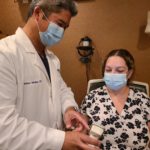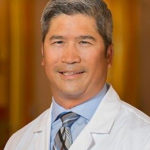
Dr. Whitley with a dry eye patient, taking time to educate the patient about the treatment plan he has prescribed.
By Walter Whitley, OD, MBA, FAAO
Nov. 16, 2022
The prevalence of dry eye disease gives no evidence of slowing down or lessening. Some 44 million people experience dry eye symptoms in the U.S.,” according to Market Scope’s 2020 Dry Eye Products Market Report.1 That means ODs have a significant opportunity to improve lives and grow profitability by expanding dry eye diagnosis and treatment services. Here is how we have been growing this important part of our practice.
Prioritizing Dry Eye: Improving Lives & Capturing A Huge Practice Growth Opportunity
As the Director of Optometric Services at Virginia Eye Consultants, I oversee the dry eye clinic with our dry eye counselor. Annually, I treat roughly 6,000 patients for a variety of dry eye/vision/medical eyecare conditions, including ocular surface disease. I also treat pre- and post-surgical glaucoma and urgent-care patients, as well as patients with diabetes who are experiencing dry eye/vision care-related symptoms.
Every patient, regardless of their reason for visiting, completes a screening questionnaire that helps eyecare practitioners (ECPs) at the practice rule out ocular surface disease. We also search for signs of dry eye as a part of the screening process for all patients.
We’ve seen tremendous growth and an increased need for dry eye services and treatments, especially in recent years. Roughly 35 percent of my daily patient schedule has ocular surface disease, and we anticipate that number to increase with time because of how common dry eye disease is, with women twice as likely to be diagnosed with dry eye as men. During my past 14 years at the practice, our growth in dry eye services is attributed to more of our providers administering dry eye services, in addition to marketing such services to referring ODs, MDs, PCPs and patients, alike.
Strong Increase in Number of Procedures Delivered
Dry eye procedures such as thermal pulsation, intense pulse light (IPL) and heat/meibomian gland expression have increased year after year, and we anticipate even more growth, especially as we acclimate to a post-pandemic environment. Of note, we experienced a 47 percent increase in growth from 2018 and 2019; and last year, even amidst the uncertainty of the pandemic, we reported a 33 percent increase in growth from 2020-2021.
Making the Dry Eye Technology Investment
Imaging technologies that allow patients to see their meibomian glands makes a great difference in our dry eye practice, enabling us to increase patient satisfaction, retention and engagement by adopting these technologies and treatments in our practice.
For years, I have offered thermal pulsation procedures (both vector and handheld) in my practice and most recently, I’ve had the opportunity to upgrade my device to Systane iLux2, Alcon’s newest dry eye device. Unlike its predecessor, Systane iLux2 is an all-in-one, handheld Meibomian Gland Dysfunction (MGD) Thermal Pulsation System that delivers targeted, fast, in-office treatment and offers new imaging technology, which captures infrared photos of the meibomian gland. What I like best about this technology is that it allows me to show patients their procedures, which helps them better understand treatment effectiveness, while they’re in the office.
I strongly recommend the use of dry eye imaging technologies because they helps contextualize the treatment recommendations I’m providing to patients. By providing a variety of dry eye offerings to patients–MGD treatment with Systane iLux2, vector thermal pulsation with LipiFlow, localized heat therapy with TearCare and intense pulse light therapy or microblepharoexfoliation with BlephEx, I can provide better care to my patients, which, in turn, can help improve their overall quality of life.
Show Patients Why Treatment Is Necessary
While many patients know the symptoms of dry eye, others are not as familiar with it. Additionally, there are many dry eye patients who are asymptomatic and, therefore, often overlooked, if we don’t properly screen for dry eye disease. When we can show patients their condition and why their prognosis is concerning, we enhance patient care by helping to provide clear, comfortable vision.
In clinical practice, we have seen a decrease in reimbursements from both medical and vision care plans. From a business perspective, we can increase profitability by producing various revenue streams including cash-based services for dry eye. When we identify our patients’ dry eye/MGD, making a strong treatment recommendation first and foremost benefits patients, while simultaneously benefiting the practice. As my colleague, John Rumpakis, OD, once said, “profitability is a byproduct of good patient care.”
Other Articles to Explore
Assess All Patients for Dry Eye
We utilize the SPEED questionnaire as a part of every new patient’s intake form, regardless of their reason for an appointment. In most cases, we do not have patients fill out the questionnaire during every subsequent visit, but we do utilize this survey to help follow our patients’ journeys and monitor symptom improvement. The questionnaire asks patients simple questions, which helps my team determine the severity and frequency of our patients’ dry eye conditions. If you don’t utilize questionnaires, another option is to ask four simple “yes” or “no” questions: “Do you have dry eye?,” “Are you bothered by red eyes?,” “Does your vision change/fluctuate throughout the day?” and “Do you feel the need to use eye drops?” If the patient answers “yes” to any of the questions, we respond with a dry eye follow-up or treatment.
To maintain practice efficiency, it is critical to prioritize and delegate tasks among your staff. Consider responsibilities that only a doctor can do and have your doctors prioritize those tasks. If you’re able to delegate tasks to technicians or other staff members (such as testing or treatment), you can streamline processes and maximize your doctors’ time spent with patients, which has a positive impact on the whole practice.
Designate Dry Eye Champion in the Practice
To create a successful dry eye practice, it is important to have an OD or MD (or multiple ODs and MDs) championing the adoption of dry eye offerings available to patients. This person (or team of people) should act as your practice’s designated dry eye counselor or concierge, serving as a go-to resource for patients. By providing a designated specialist (or team of specialists), your patients will have a clear, dry eye point of contact and, in turn, will be better informed about the treatment options available and how procedures are performed.
Evolve with New Treatment Offerings
Areas we’re keeping a close eye on are low level light therapy (LLLT) and radio frequency (RF), both of which are relatively new in the space and have amassed limited data.
I have performed LLLT on a dozen MGD patients so far, and the early experience has been positive. There have also been several case reports showing successful application for recurrent chalazia and styes/hordeola.
Radio frequency is mainly used for aesthetics, and is not FDA-approved for dry eye, but this may be a potential opportunity to help patients not only look better, but feel better too.
References
1. Market Scope, 2020 Dry Eye Products Market Report, page 34
 Walter Whitley, OD, MBA, FAAO, is Director of Optometric Services at Virginia Eye Consultants.
Walter Whitley, OD, MBA, FAAO, is Director of Optometric Services at Virginia Eye Consultants.

























